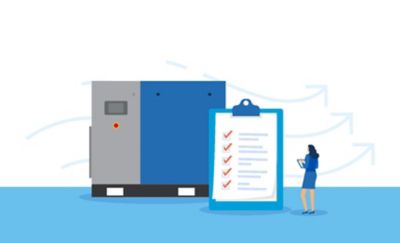Running an air compressor is more than just about operating switches. One of the main aspects is compressor maintenance in order to keep the machine efficient and ensure a long life.
Unfortunately, it often happens that mistakes are made in the maintenance process. Underestimating risks can result in inefficiency, breakdowns and production waste and results in economic losses, often very high.
Here you can read about the main causes of a compressor breakdown:
1. Underestimating Energy Costs
2. Not Inspecting Components
3. Ignoring Air Leaks
4. Underestimating Pressure Losses
5. Accumulation of Dirt in the Pipes
6. Condensate Drain Problems
7. Checking the Air Demand of Individual Departments
8. Preventing Malfunctions
1. Underestimating Energy Costs
One of the main mistakes is to underestimate or miscalculate the amount of energy that a compressor uses.
In fact, energy costs can exceed the cost of purchasing the compressor itself already in the first 12 months of use. Consumption increases when operators are not aware of the overall energy costs and use the compressor inefficiently.
To ensure efficiency, it is important to accurately calculate the annual energy costs of an air compressor and make sure that all personnel are aware of it, thus avoiding expensive use.
2. Not Inspecting Components
Although the compressor is the central element of a compressed air system, compenents are also an integral part of your system. Components must be treated with the same routine maintenance In particular, the air tank that reduces wear and contamination of the system.
The tank allows you to operate the compressor at lower levels and save energy during the process. If the tank is undersized compared to the system, the compressor must operate longer than necessary to keep up with the air demand.
3. Ignoring Air Leaks
Air leaks can waste up to half of the air produced within a compressed air system. When it comes to the operation of an air compressor, some of the greatest savings can be achieved with regular maintenance of air leaks. This includes not only the pipes but also the valves, connections and accessories.
4. Underestimating Pressure Losses
One of the main problems that emerges in compressed air systems is the pressure loss between the compressor and the point of use. Although a certain amount of pressure loss in inevitable; it should never exceed 10% during a given application to avoid stressing the compressor, causing it to wear faster.
Pressure loss is usually caused by pipe tightness problems and weak points in filters and dryers. Unfortunately, system operators often compensate for pressure loss by increasing system pressure, which results in more expensive operations. The correct way to handle this problem is to check for problems with the filters and dryers and replace some items if necessary.
5. Accumulation of Dirt in the Pipes
It is crucial that the pipes of the air system remian clean and free of dirt, rust or other deposits. When contaminants are present, the air pressure drops and problems continue to increase if they are not resolved. If the pipes are not properly cleaned, contaminants could reach the pneumatic tools.
6. Condensate Drain Problems
Condensation is formed during the cooling process when moisture is sucked in from the air. Several problems can occur if condensate droplets accumulate inside the air compressor. These include:
- condensate "washes away" the oil and pneumatic tools are less lubricated
- Low output air quality
- rust or limescale in the airflow
- water accumulates inside the machine and ruins the circuits
- condensate can overload the air dryers and ruin in-line filters
Condensation problems are often found in rotary screw air compressors, where compressor oil sometimes spreads into the air system mixing with condensate. The combination of oil and water can lead to dirt deposits that eventually clog the exhausts and pneumatic tools.
Problems arising from condensation also derive from the operation of the exhausts of the system. The drains, designed to cope with condensate, are placed at strategic points along the system, such as the tank, dryer and aftercooler. If the drain fails to drain the condensate, a mixture of water, oil and dirt accumulates inside until it clumps.
For this reason, the correct functioning of condensate drains must be checked periodically.
7. Checking the Air Demand of Individual Departments
In a widespread industrial plant, the need for compressed air may differ from one department to another. Pressure is inevitably wasted when the entire air system is operated at a higher pressure just to meet the needs of individual departments that require higher demand.
In multi-department systems that use a large number of air compressors, it is crucial to assess the needs of each department. This will help to determine which ones have greater needs than the others. For departments with a higher demand, additional compressors should be installed to meet their needs. In this way, the rest of the system can operate at an even pressure without wasting the air pressure.
Condensation problems are often found in rotary screw air compressors, where compressor oil sometimes spreads into the air system mixing with condensate. The combination of oil and water can lead to dirt deposits that eventually clog the exhausts and pneumatic tools.
Problems arising from condensation also derive from the operation of the exhausts of the system. The drains, designed to cope with condensate, are placed at strategic points along the system, such as the tank, dryer and aftercooler. If the drain fails to drain the condensate, a mixture of water, oil and dirt accumulates inside until it clumps.
For this reason, the correct functioning of condensate drains must be checked periodically.
8. Preventing Malfunctions
Identifying problems within your compressed air system is a way to save time and money. Often, however, companies fail to record and evaluate data related to system operations. Without the knowledge, it is difficult to spot inconsistencies and identify malfunctions.
The secret here is to collect system performance data regularly to determine the range of behaviours that characterise a functioning air system within a given environment. Readings must be taken at various points along the system, including compressors, aftercoolers, receivers, filters and pneumatic instruments. Once accepted patterns are established, deviations in performance can act as warning signs for potential system problems.
Get tailored advice
Still have questions after reading? Our expert is ready to help you make sense of it all and guide you to the best solution.
Write to an Expert Today – Get the answers you need.





